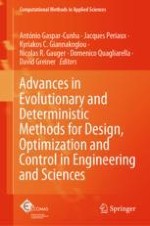2021 | Book
Advances in Evolutionary and Deterministic Methods for Design, Optimization and Control in Engineering and Sciences
Editors: Prof. António Gaspar-Cunha, Prof. Jacques Periaux, Prof. Dr. Kyriakos C. Giannakoglou, Prof. Dr. Nicolas R. Gauger, Dr. Domenico Quagliarella, Prof. David Greiner
Publisher: Springer International Publishing
Book Series : Computational Methods in Applied Sciences
